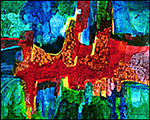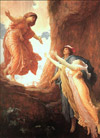Until the mid 1800s, the art cognoscenti in Europe insisted that the proper subject for great art was either, myth, history or religion. No other subjects were considered appropriate. Gustave Moreau, the famous teacher of Georges Roualt and Henri Matisse, completed some 8,000 fascinating, elaborate paintings of biblical and mythological subjects. His museum at 14, rue de La Rochefoucauld in Paris was his studio. It is fantastic! All the modern and contemporary art that followed let this elaborate, emotional grandeur fall away. Artists began working at understanding simplicity, the ordinary, the banal. Minimalism is restful after centuries of drama, but leaves a void. The Rothko Chapel in Houston is all black ceiling, floor, uniformly black wall paintings may provide sensory deprivation as a religious experience, but how many people would return again and again to sit in the dark? The story windows at Chartres, just as an example, have connected to the energy of transcendence of daily life for centuries by reminding us of stories about human beings like ourselves experiencing their lives. We are human beings on the earth and a great deal of how we use the experience depends on the myths we know. These stories are our inherited frame of reference.
Even when we cannot easily understand a painting, i.e. El Greco’s Laocoön, we have no doubt that something important is taking place and that we are diminished to the extent
that we cannot understand. The story relates how the hero, a priest in Troy, attempted to warn his countrymen of the Trojan horse, whose hollow body concealed Greek soldiers.
Laocoön was punished by the gods, who sent serpents out of the sea to kill him and his two sons, a consistent historical problem for “truth-tellers.”
Virginia Mallard Virginia Scribner in her spectacular recent show at the Wilmette Library, “Cosmos and Cultures” uses Greek, Mycenaean and Celtic myths to make both magnificent contemporary art, but powerful political statements that she felt could be more readily considered in a mythic context. “If you talk about Afghanistan or Iraq, people start screaming at each other…and at YOU! All communication breaks down. If I use hoplites (ordinary Greek soldiers) or Ajax and Achilles, I can “say” whatever I like and possibly someone will start to think instead of shutting down emotionally and intellectually.” She has been asked to teach an interdisciplinary course to inspire Loyola Academy’s students to use these resources.
Myths provide shortcuts to enrich the meaning of individual works. If there is an apple or a serpent, a dog, a Trojan horse, we have a
great deal of information at first glance. Franco Muscarella uses mythic references so effectively to enhance and clarify the meanings of his contemporary works, i.e. Fortitude
or Piling on Toward Eden. People respond and are buying his art because it “speaks to them.” When Chicago artist Anne Gaines wished to digest and comment on a personal event in her life, she used the myth of Demeter and Persephone. Marge Graham uses the same myth in her illustrated book with a completely different emphasis. Returning to ancient Minoan culture for her inspiration both the myth and the style of art have the effect of validating women’s rituals, rather than a private moment. Gabriel Rossetti chose the six pomegranate seeds as his theme and created a beautiful masterpiece. This myth is powerful on so many levels. It is the story of kidnapping, rape, fertility and barren earth, mother love, human frailty when confronted by temptation and the clinging of the “dark side” to life without which its darkness has no substance. With only six pomegranate seeds eaten secretly, Persephone dooms herself to return to the underworld, proving that there are no secrets. This is great stuff! As with so many things that have “been forgotten” or gone underground, when they surface and have value for us, we feel the connection at first touch. Although many of our great institutions i.e. Columbia University, Harvard, University of Chicago have stopped requiring “the classics,” thoughtful artists know they need them. We go back because only the surface conditions of our lives have changed over the millennia. The emotional and spiritual interior of each of us and our relationships have changed only a little. The myths combined with art give us this window into our humanity. We have them as a back-story to keep us honest and in touch with our own greatness.
To go deeper: Homer –The Iliad and The Odyssey Ovid – The Metamorphosis Joseph Campbell – all works. My favorite is Hero with a Thousand Faces For children of all ages: D’Aulaire’s Book of Greek Myths D’Aulaire’s Book of Nordic Myths



